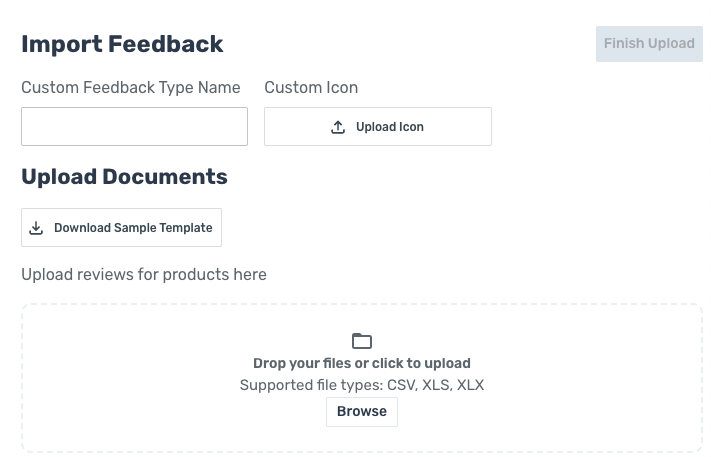Synthetic Data for Market Research
AI-powered customer feedback so you can take action now
Native AI turns insight into impact
Introducing Native AI, the always-on market intelligence platform that helps you understand, innovate, and create ideal experiences for your customers.

A better way to find the answers you need
Create impact through measurable improvements to products, customer experience, and marketing.
-
Analyze millions of qualitative and quantitative data points
-
Automate product and keyword tracking across the web
- Converse with digital clones of your customers in real-time
Insights Dashboard
Customize and export reports with full choice of visualizations. Set up alerts for specific products and keywords, and monitor trends over time in order to predict future consumer behaviors and identify white-space opportunities.


Bring Your Own Data
Upload your first party data in any structured or unstructured format. Our platform is compliant with international data processing regulations to eliminate unnecessary risk.
Digital Twins
Converse with digital clones of your customers or your competitors' customers. Filter by demographic, purchase channel, behavior, and more. Create visualizations and export your results.

Expert White-Glove Service
Our platform is designed for you to be successful independently, but we're here to make sure you’re able to take full advantage of the value Native AI provides.
The Native AI Difference
We're not like other all-in-one insights platforms. Get a peek under the hood.
Data Safety & Privacy
Advanced Orchestration
Synthetic Output Controls
Synthetic Data for Market Research
The advent of AI technology has revolutionized the process of market research, bringing forth ingenious tools such as synthetic data. The boon of synthetic data in market research can't be overstated, hailing a new era of efficiency when it comes to insights and analytics. What makes it stand out is its ability to simulate real-world scenarios, permitting businesses to examine a multitude of possible outcomes, strategies and decisions without risking actual resources.
One potent application of synthetic data can be seen in the form of synthetic audiences. In essence, a synthetic audience refers to a virtual or simulated group of individuals, originated from algorithms that utilize real data to create audience-like simulations. Having access to a synthetic audience allows businesses to test marketing strategies, advertisements, products and much more in a risk-free, yet real-like environment.
Here’s an example of a use case for a synthetic audience. A sports drink company could generate a synthetic audience comprising individuals interested in health and fitness, and test their new energy drink's marketing campaign – analyzing its potential influence and reception, making adjustments accordingly, before launching it in reality.
In short, synthetic data in market research not only provide opportunities to test and sharpen strategies, but also contribute to mitigating risks, ultimately helping businesses to thrive.
Synthetic Data Generation
Synthetic data generation encapsulates the process where artificial intelligence (AI) technology is used to simulate real-world user behaviors or actions, mimicking the natural patterns in data while protecting user privacy. This groundbreaking technology opens up a plethora of opportunities for businesses and researchers alike in various fields.
Synthetic data generation has considerable implications for user research, a domain where AI tools are rapidly gaining traction. Traditionally, user research involved direct engagement with users through interviews or surveys. However, with AI user research tools, it is now possible to simulate user behavior using synthetic data, thereby broadening the scope of research without infringing on user privacy.
The concept of synthetic users can seamlessly integrate into this new paradigm of user research. These are artificial representations of real users, created by AI algorithms, which mimic their behaviors and actions within predefined parameters. This paves the way for researchers to conduct extensive and in-depth studies without directly involving the users.
Synthetic Data Examples
Synthetic data is all around us, even though we may not realize it. It’s also not an entirely new concept.
One might remember the popular game Grand Theft Auto V, among others. Those games' developers created synthetic images of traffic situations, which they used to "teach" self-driving software how to respond to real-world scenarios. Machine learning algorithms trained on this data would, theoretically, perform more safely on the streets.
While synthetic data generation methods vary, one effective strategy involves using generative AI. These models hold immense potential in creating digitally constructed data that mirrors original statistics. Deep learning techniques such as GANs (Generative Adversarial Networks) represent the pinnacle of synthetic data generation using generative AI.
Discussing the synthetic data use cases leads us to healthcare, finance, retail, among others. In healthcare, synthetic data can ensure patient privacy while still allowing for crucial research. In finance, it helps in stress-testing and model validation.
Often confused with synthetic data is the concept of simulated data. However, while they are similar, there's a subtle difference. Synthetic data is generated from existing datasets, retaining the properties, correlations, and distribution structures, while simulated data is model-driven, and it's manually designed to simulate real-world situations. Understanding synthetic data examples helps unravel this difference further.
Regardless of the methods and applications, synthetic data certainly marks a promising frontier for AI, machine learning, and data privacy. The innovation in this arena continues to grow, offering an improved and regulated environment for data sharing and analysis.
